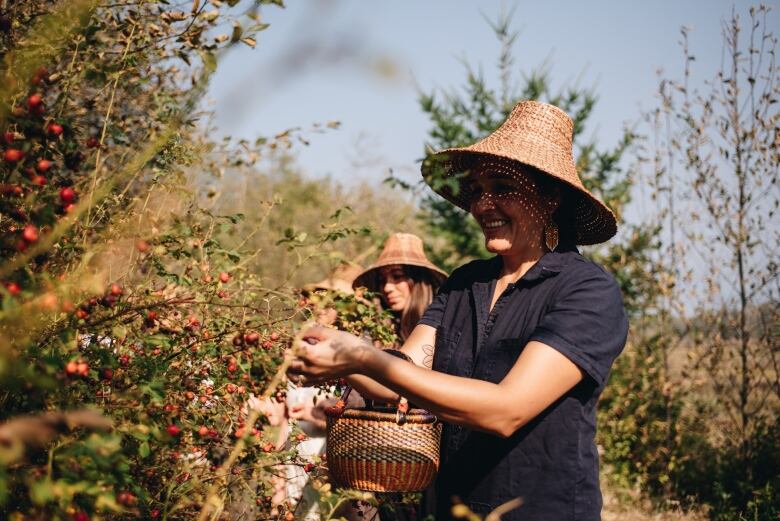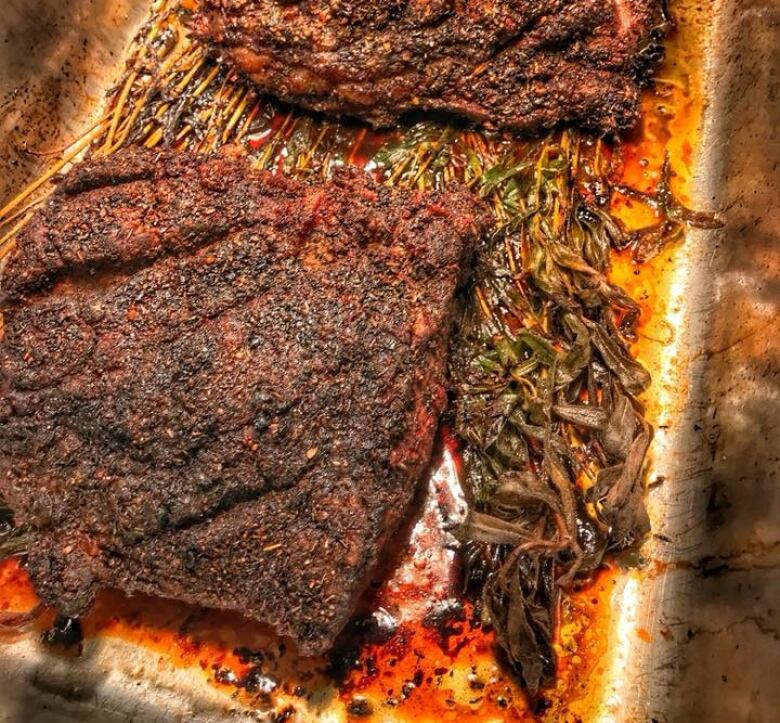Chef Rich Francis describes diners’ reactions as “shock and awe” when they try some of the food items at his Seventh Fire dinners.
“The initial time they have a chunk of beluga whale that is been buried in espresso beans and vanilla, [they’re] like: ‘What?'” he claimed.
He is been hosting dinners that he phone calls “resistance delicacies” — the sale of wild recreation meat in dining places is prohibited in Ontario — at the Six Nations of the Grand River reserve in southern Ontario.
Francis, a member of the Tetlit Gwich’in and Tuscarora Nations, is no newcomer to bold culinary moves in 2014, he placed 3rd on Top Chef Canada. But he isn’t really in this article just aiming to surprise patrons’ palettes.
“The Seventh Hearth is an Anishinaabe prophecy that states that seven generations back is when all the unfavorable stuff started off to transpire for Indigenous persons,” he instructed Unforked host Samira Mohyeddin. “The assimilation, the colonization, household universities, all of that stuff.”
Present day Indigenous cuisine takes a glimpse at the current troubles we deal with as Indigenous individuals now. My automobile to address that is food items.– Prosperous Francis
Francis and other Indigenous folks in Canada are acquiring strategies to rediscover aspects of their traditional cuisine just after the effects of colonization — which includes household educational institutions — severed these connections to their ancestors.
“Modern-day Indigenous cuisine can take a look at the latest problems we experience as Indigenous folks. My motor vehicle to address that is foods,” he claimed.
Francis may possibly channel personalized recollections traveling to fishing camps with his family members as a younger boy residing in Fort McPherson in the Northwest Territories. Or, he may create a plant-based mostly menu encouraged by the Haudenosaunee nations, who he stated ate vegetable rich eating plans.

For Francis, whose father was pressured to show up at residential college, it is specially poignant when he’s capable to spark reminiscences of superior periods.
“Quite a few moments, elders have appear up to me and reported, ‘You know, this reminds me [of] just before I went to household school,'” he recalled. “Even now … you get a lump in your throat speaking about it.”
Accessibility to the land
Foods was applied as a “weapon” against Indigenous youngsters, and its results resonated via subsequent generations, said Leigh Joseph, an ethnobotanist and member of the Squamish Very first Nation in B.C.
It was wielded in quite a few ways in residential educational institutions, she mentioned, including “as a result of hunger, by means of experimentation, or simply through acquiring great meals for the individuals performing at the university, and getting in essence rotten food … or quite, pretty lousy top quality meals for the little ones.”
Manny Jules, a survivor of the Kamloops Indian Household University, explained his father, who was at the school in the 1940s, remembered that the youngsters were always hungry, whilst employees ate properly.
“He normally questioned why, due to the fact there was lots of eggs, plenty of beef, loads of produce, but the kids failed to get it,” Jules told The Latest.

The suspected remains of 215 children were uncovered outside the house the Kamloops faculty previously this thirty day period.
Previous 7 days, the Cowessess Very first Nation introduced the preliminary discovery of 751 unmarked graves at the former Marieval Indian Residential University in Saskatoon.
For Joseph, undoing that destruction to Indigenous people’s romantic relationship with food items includes foraging places in forests, estuaries and the B.C.’s subalpine location (the forested location of a mountain just underneath the tree line).
She works with Indigenous communities by taking people today out to the land to harvest regular foods like mountain blueberries, stinging nettles and balsam fir pitch, which is utilised as a medicinal tonic.
“You will find so significantly embedded in that practical experience. One particular, we are trying really neat food stuff. Two, it preferences awesome. But 3, our ancestors ended up forbidden to entry these foodstuff. Our ancestors had been explained to these foodstuff were being poor for us — were being evil. We could not take in them,” she reported.
The practice of foraging, and planning foods with these components, was forcibly taken absent from past generations of Indigenous individuals when they were being taken off from their land by European colonists, Joseph stated.
The results of that, compounded by weak nourishment at household colleges, can nonetheless be felt now Kind 2 diabetic issues is one of the primary wellness considerations for Initially Nations, Inuit and Métis people in Canada.
According to Diabetes Canada, Indigenous persons are diagnosed with diabetes at a youthful age, have additional significant symptoms, and facial area better premiums of troubles than the standard populace.

To Joseph, increasing Indigenous people’s “access to the land” has broad beneficial effects on their physical and mental wellness.
“Just one of the points I like is to just hear men and women on the landscape, you know, listen to people today speaking and laughing,” Joseph stated.
She recalled serving to elders with mobility concerns vacation safely and securely to check out the subalpine, or viewing children playfully mash freshly harvested blueberries into each individual other’s faces.
Pay attention | Indigenous chef Bertha Skye remembers the 1992 Planet Culinary Olympics:
Unforked3:00Bertha Skye remembers the 1992 World Culinary Olympics
Bertha Skye is a member of the Ahtahkakoop Cree Country and has been lauded as just one of the culinary matriarchs of Indigenous food stuff. She was aspect of the workforce of Indigenous cooks who represented Canada at the Earth Culinary Olympics in Frankfurt, Germany in 1992. They received eleven medals that calendar year, additional than any other team. Bertha Skye recollects that encounter and how it felt to garner these large praise from the intercontinental local community. 3:00
What about bannock?
Francis is also finding inspiration from foraging, or working with herbs and plants — like a thunderbird smudge, which he encountered in a Cree ceremony.
“I kind of smelled it and I was like, ‘Oh my god, this would style so freaking excellent on a buffalo steak,'” he recalled.
“The irony, once more, is it is always been below … All I do is link the dots, in essence, of what is actually currently there.”

Francis also hosts “decolonizing workshops” for Indigenous youth in cities like Toronto and Vancouver, teaching them how to make regular meals they may perhaps have by no means heard of in advance of.
“You see this minimal mild bulb happen in their eyes, wherever their foods memory or their food DNA is activated just like intergenerational trauma,” he explained.
But he would not teach his cooks how to make food items with ties to what he phone calls “the colonial foods process that practically killed us.”
That features bannock, the fried bread ubiquitous in quite a few Indigenous communities, but whose intricate origins can be traced to Scottish settlers.
“Bannock is listed here to keep, will not get me erroneous. It is a symbol of survival for us … but we do not have to try to eat that way anymore,” he stated.
“As a up to date Indigenous chef, it can make no perception for me to put that stuff out there.”
Written by Jonathan Ore. Manufactured by Levi Garber.
